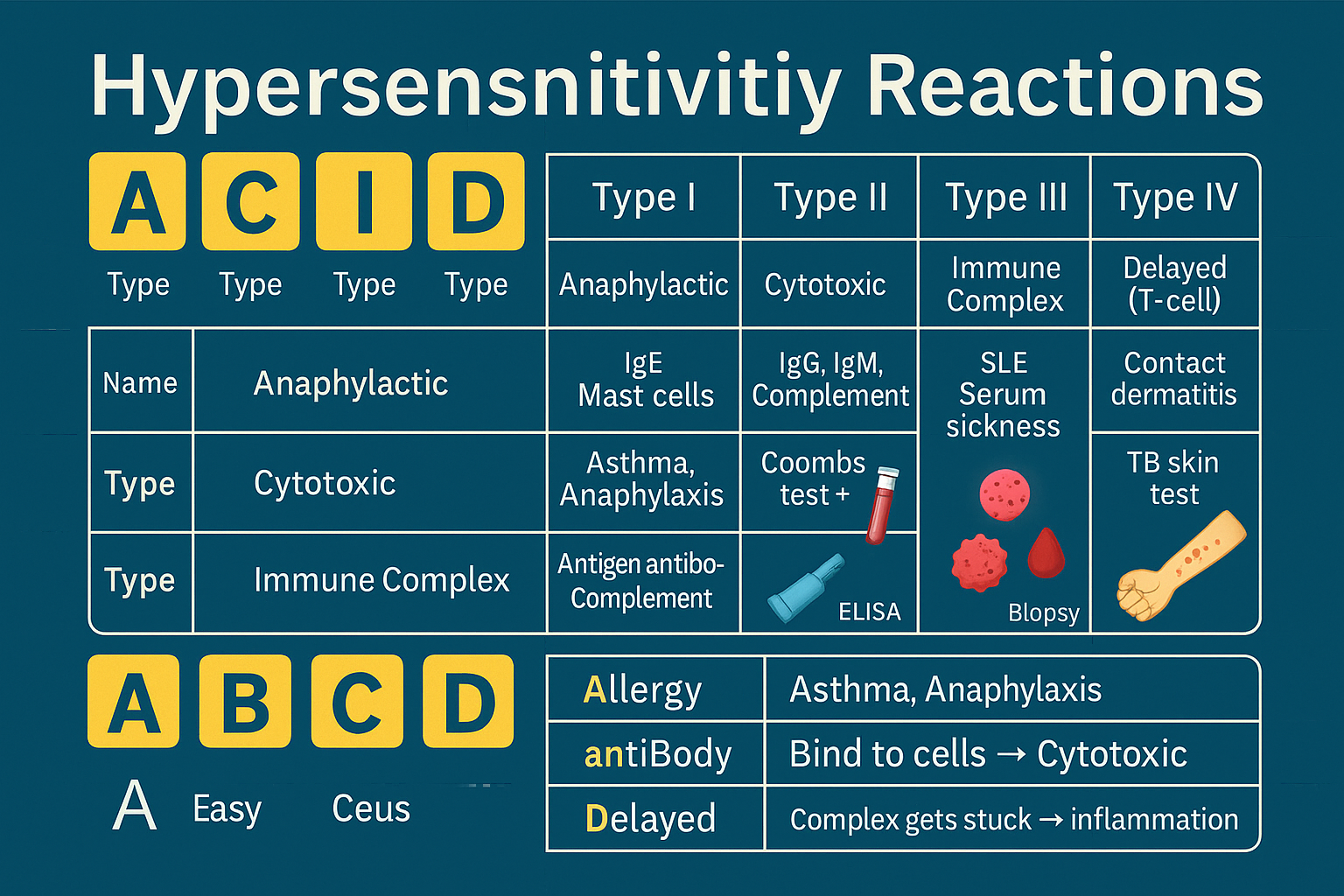🧬 Hypersensitivity Reactions: The 4 Types, Mnemonics, and Clinical Vignettes
The Gell and Coombs classification of hypersensitivity reactions breaks immune responses into four types. These often appear in Step 1 vignettes where you need to deduce the underlying mechanism based on time of onset, type of immune mediator, or result of a lab test (like Coombs).
Let’s simplify these four with mnemonics, mechanisms, and must-know examples.
🧪📘 Mnemonic: ACID
A - Type I: Anaphylactic
C - Type II: Cytotoxic
I - Type III: Immune Complex
D - Type IV: Delayed (T-cell)
🧪 Hypersensitivity Overview Table
| Type | Name | Key Mediators | Example Conditions | Notes |
|---|---|---|---|---|
| I | Anaphylactic | IgE, Mast cells | Asthma, Anaphylaxis, Allergies | Immediate onset (minutes) |
| II | Cytotoxic | IgG/IgM, Complement | Graves, Goodpasture, Hemolytic anemia | Antibodies target host cells |
| III | Immune Complex | Ag-Ab-Complement Complexes | SLE, Post-strep GN, Serum sickness | Complexes deposit in tissues |
| IV | Delayed (T-cell) | CD4/CD8 T cells | TB skin test, Contact dermatitis, GVHD | Delayed onset (48–72 hours) |
🎯 Fast Clinical Clues
Type I: Sudden onset post-exposure (bee sting, peanuts)
Type II: Direct cell attack (positive Coombs test, hemolysis)
Type III: Immune complex damage (kidneys, joints, serum)
Type IV: TB PPD, poison ivy, graft-versus-host disease
🧠 KOTC Tip: Remember “I and II = antibody, III = complex, IV = delayed cell”*
🧠 Extended Mnemonic: ABCD
| Letter | Type | Reaction | Memory Trigger |
|---|---|---|---|
| A | I | Allergy | Asthma, Anaphylaxis |
| B | II | antiBody | Antibody binds cells → cytotoxic |
| C | III | immune Complex | Complex deposits → inflammation |
| D | IV | Delayed | T-cell reaction (48–72 hr delay) |
📌 Before You Go…
Don’t let immunology overwhelm you. Use KOTC’s visual-first learning style to lock it in.
✅ Call-to-Action (CTA)
Master immunology with KOTC’s adaptive Q-bank, immuno flashcards, and animated mnemonics made for real retention—not just short-term memorization.
👉 Get started here
Frequently Asked Questions (FAQs)
-
Aim for 4-6 focused hours, ensuring you incorporate breaks to avoid burnout.
-
Practice mindfulness techniques, take practice exams under realistic conditions, and maintain a balanced lifestyle.
-
Set short-term goals, seek support from mentors, and reward yourself for small achievements.
-
Regular exercise improves focus, reduces stress, and enhances overall mental clarity.
-
KOTC offers personalized learning tools, gamification features, and adaptive question banks to help students stay on track without burnout.


